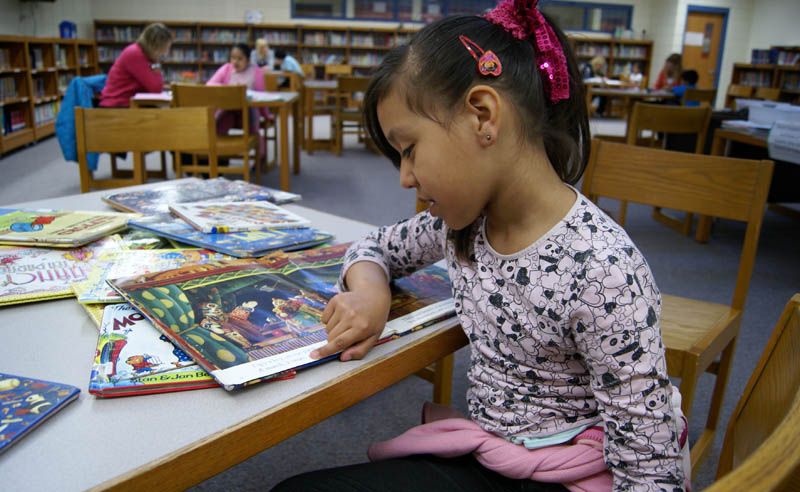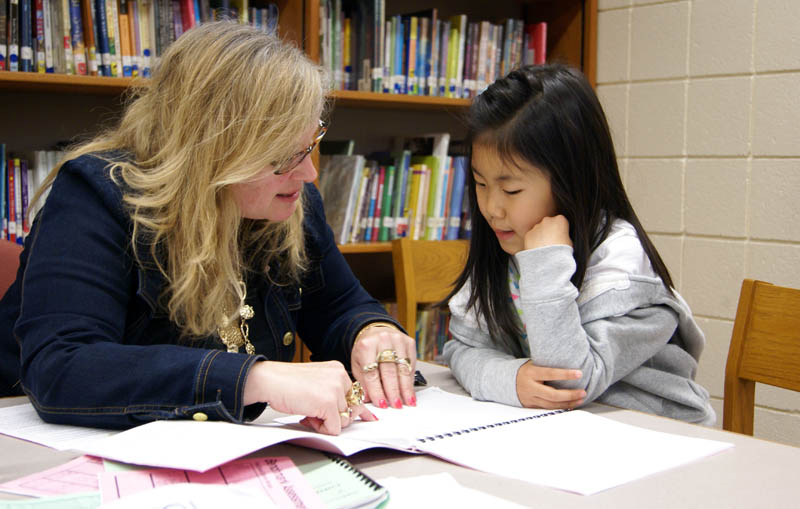How one West Michigan school district is closing reading gaps for poor, Hispanic students

(Part 2 of 2) See Part 1 here: One Dearborn school soars, another stumbles and Grand Rapids cites the limits of state rankings to explain school gaps
When it came time to enroll their daughter in kindergarten, Jose and Maria Garcia knew she faced a tremendous challenge. Neither she nor they spoke a word of English.
Yet they were determined she would get the best education available so she could have a life better than theirs. It was why they had come to Holland, Mich., from Mexico, and why they toiled at low-paying migrant jobs, moving with the seasons to follow the work.
As summer moved into autumn, Jose Garcia had no idea which school his daughter, Yessica, should attend, so he did what seemed most logical: He put the little girl in his car and followed a school bus that pulled into the migrant camp, a collection of stark apartment buildings surrounded by Ottawa County farmland.
Everytime the bus stopped to pick up more children, Jose Garcia’s car stopped behind it. After a while, the bus driver became suspicious and finally confronted Garcia. Despite a language barrier, he was eventually able to persuade the driver his intentions were honorable. He simply wanted to enroll Yessica in kindergarten.
MORE COVERAGE: “Rich school, poor school, and the challenges that separate them”
As luck would have it, the migrant camp was in an area served by Lakeshore Elementary, a West Ottawa Public School north of Holland. Lakeshore had a record of helping children such as Yessica overcome the barriers of language and poverty, raising them to the academic levels of students in more affluent schools.
Thirteen years later, Yessica graduated in the spring of 2014 from West Ottawa High School in Holland near the top of her class with a grade point average above 4.0, when weighted for credit she received for advanced placement classes. Now 19, she recently completed her first year at Western Michigan University with a scholarship covering her tuition.
“I never had a bad teacher,” Yessica said of her education. “Nobody ever told me I couldn’t do it. They challenged us. They would push us to the next level. They would say, ‘If you can read this, then now you can read a chapter book.’”
The district’s gift for raising the reading skills of students for whom English is a second language shows up in test scores.
In the early elementary grades, Lakeshore’s Hispanic students generally score lower in reading than the school’s non-Hispanic white students. At the beginning of third grade in the 2013-2014 school year, for example, 72.7 percent of the Hispanic students were proficient in reading compared with 84.8 percent of white students at the school. That same year, 77 percent of Hispanic fifth grade students scored proficient in reading. By eighth grade, the difference in reading achievement between Hispanic and non-Hispanic students in the district had virtually disappeared.
Reading achievement, particularly by the end of third grade, is a key predictor of a student’s future success in school and, ultimately, in life, research shows. It’s the reason why Gov. Rick Snyder and state lawmakers have been searching for ways to get more Michigan children to read proficiently by third grade. In Part 1 of this series, Bridge analyzed how two elementary schools with similar student populations in the same district (Grand Rapids and Dearborn) could perform so differently on third-grade reading exams.
Lakeshore presents a different, more optimistic dynamic: an elementary school filled with poverty and language challenges that is not only able to get students on a path to reading at grade level, but to compete with the district’s white, more affluent students and schools.
“If they can’t read, they’re going to fall behind in other subjects,” said Sarah Lenhoff, director of policy and research for the Education Trust-Midwest, a Michigan-based nonprofit that conducts studies and advocates ways to close the achievement gap among schools. “Reading is absolutely key,” she said. “It’s essential. It’s pretty remarkable how much that is likely to translate into success later in life.”
Students who can read well by the end of third grade are more likely to graduate, go on to college and find well-paying jobs, according to a 2015 Education Trust-Midwest study, “Michigan Achieves: Becoming a Top Ten Education State.” Those who are not proficient in reading by third grade are more likely to drop out of school, break the law, become dependent on government assistance and earn far less than those who graduate and attend college, the study said.
Michigan’s schools rank near the bottom of other states in academic achievement, particularly in reading, and risk slipping further behind, Lenhoff said.
“Clearly, Michigan needs to do something about this issue,” she said, adding: “We can learn from places like Lakeshore.”
A diverse mix
Lakeshore Elementary is one of nine elementary schools in the West Ottawa Public Schools district, which draws more than 2,300 students from Holland and nearby rural areas where many migrant families live and work. Lakeshore is an anomaly, drawing an economically diverse range of students from the multi-million dollar homes on the Lake Michigan shore less than a mile away, as well as those who live in the spartan migrant camps, where families come in the warm months to work in the nurseries and blueberry farms.
A few miles away from Lakeshore in the same district, Waukazoo Elementary serves a less diverse and more uniformly affluent population, including students who come from the exclusive neighborhoods along Lake Macatawa.
About half of Lakeshore’s students receive free or reduced price lunches – a measure of the area’s poverty rate – compared with about 20 percent of Waukazoo students. More than 30 percent of Lakeshore’s students are Hispanic, including many who spoke no English when they started school. That’s more than twice the Hispanic enrollment of Waukazoo. Given the challenges presented by higher poverty and many students’ lack of fluency in the English language, Lakeshore should not be able to compete with a school like Waukazoo.
Yet when it comes to academic achievement, the two schools are comparable. In tests given at the beginning of the 2013-2014 school year, 81 percent of Lakeshore’s fourth graders were proficient in the reading portion of the statewide MEAP test compared with a statewide average of 70 percent. (Because MEAP tests were given near the beginning of the school year, exams taken in fourth grade are a better barometer of third-grade reading skills)
Among the school’s Hispanic fourth graders, the same portion – 81 percent – were proficient in reading in 2012, well above the statewide average of 58 percent for Hispanic students. A slightly higher portion of Waukazoo’s fourth grade students – 88 percent – were proficient in reading in 2013-2014, but a year earlier, Lakeshore’s fourth graders scored even better than those at Waukazoo – 88 percent for Lakeshore and 85 percent for Waukazoo.
In 2014, the U.S. Department of Education honored Lakeshore Elementary as one of seven schools in the state to be named a National Blue Ribbon School for academic achievement. The past two years, the Michigan Department of Education gave Lakeshore its “Beating the Odds” award for overcoming educational barriers, including language and poverty.
In Bridge’s Academic State Champs rankings released in February, in which a school’s poverty level (but not students’ English-language skills) is taken into consideration, Lakeshore Elementary placed 18th out of 1,210 Michigan elementary schools.
“We know we have a high population of need,” said Jens Milobinski, Lakeshore’s principal. “We’ve got to be really diligent, work really hard to get those kids caught up. I tell the students, I’m an English-as-second-language student, just as they are.”
He was born in Germany and spoke only German until his parents immigrated to this country when he was a child.
“One thing I’ve talked about is ‘every student, every day,’” Milobinski said. “It sounds simple, but it’s that expectation I have for all of my students to be proficient.”
In meetings with teachers, when they celebrate their student’s reading abilities, Milobinski sometimes reminds them that even those high scores aren’t good enough. Would you settle for your child being one of the students who can’t read? he asks.
“If we’re not having all of our kids achieving proficiency, then we have a long way to go,” Milobinski said.
The school uses a method called Response to Intervention (RTI) to identify those students who need extra help in reading.
“Every school is going to say they’re doing RTI,” Milobinski said, “but are they doing it well?”
On a recent morning in the Lakeshore Elementary library (for the benefit of Hispanic students and parents, a sign identifies it as the “biblioteca”) teachers huddled one-on-one with students, administering a reading test called DIBELS. Three times a year, teachers give the test, which stands for Dynamic Indicators of Basic Early Literacy Skills, to monitor each student’s reading progress.
Those who have trouble reading are given two additional one-on-one reading sessions every day, one from a resource teacher and the other from their classroom teachers. Every six weeks, Milobinski meets with teachers and the school psychologist to review data on each student’s reading ability and assess which ones need additional help, either with overcoming a language barrier or with reading in general.
“It sounds like they’ve got the processes in place,” said Lenhoff, the Education Trust-Midwest policy expert. “The data piece is really important. If you don’t know the problems early on, it’s hard to know what to do.”
Equally important is employing teachers who are passionate and committed to teaching and have the skills to infuse their students with a love of learning, she said, as well as parents who are engaged in their children’s education.
“It’s a community effort,” said Denise Archer, who teaches English to Lakeshore’s Hispanic students. “It’s finding out what each kid’s needs are and meeting those needs. We really push our kids in a good way. If the kids know you care, they will try their best.”
In addition to students from its geographic area, Lakeshore Elementary draws non-Hispanic students from throughout the district for its Spanish immersion program.
First grader Lovel Kim sat down with Archer for her turn at the DIBELS test. Her native language is Korean. In preschool, she learned English. In kindergarten, she learned Spanish, and by first grade she was able to read chapter books in English. She is 6 years old.
“I have second graders who have unlocked the code,” Archer said. “They want chapter books. They see other kids reading them, so they want them.”
At a nearby table, Sarah Schuch, who teaches special needs students, administered the DIBELS test to another student. Over Christmas break, she gave bundles of books to two brothers who were having difficulty reading, and she called them every day so they could read to her.
“It made quite a bit of difference,” she said. “They thought it was pretty neat that I called them. It means a lot for me to have them keep reading, to keep that self-esteem going that they can read.”
In a fifth grade classroom down the hall, teacher Chad Dewitt projected on the wall the number of points each student had earned for reading books in fourth grade. Write down those numbers, he told them, and he then projected the points each had earned so far in fifth grade. Most had amassed more points this year. The goal is not to make reading something the students have to do, but that they want to do, Milobinski, the principal, said.
Ten-year-old Juan Hernandez, a fifth grader who spoke almost no English when he started kindergarten at Lakeshore, had nearly doubled the number of books he had read the previous year.
“I want to push myself and finally be proud of myself,” Juan said. “I love it. It’s like my own adventure.”
Migrating to schools
Like other children of migrant workers, he faces the additional challenge of having his education interrupted when the family moves during the year. In Juan’s case, the family usually leaves in early November for work in the South, then returns in February or March. His teachers send him off with books, so he can continue reading. Many of the migrant families head to Florida and Texas in the fall and winter, where they work in citrus groves or pick strawberries or other produce. Some return to Mexico, until harvest time back North.
“They typically regress quite a bit,” Milobinski said. “The biggest thing I hear from my teachers is, ‘Let me keep them all year.’”
Yessica Garcia Melendez (she uses her father’s surname and her mother’s maiden name), the honors student now at Western Michigan, remembers what it was like leaving Lakeshore for another school only to return months later. During the summer and early fall, her family lived in Pine Acres, a collection of apartment buildings for migrant workers in the rich Ottawa County farmland a few miles inland from Lake Michigan. Across the road, a new country club, Macatawa Legends, rose in recent years from the rolling farmland along with pricey condominiums, a stark reminder of the wide income gap between many area residents and its seasonal workers.
Each autumn, when Yessica’s father’s work in a nearby nursery ended, he moved his family, and then returned in the spring. Other students would ask where she had been.
“It got really hard to explain to them,” Yessica recalled. “They would look at me like they didn’t understand. They’d talk about vacations, like going Up North, and I was like, where’s Up North?”
Eventually, she began telling classmates she’d been on vacation.
Her father, Jose, recalled that when she first started kindergarten at Lakeshore, Yessica spoke gibberish, mimicking the English words she had heard. By the end of first grade, she spoke English quite well. Her teachers encouraged her to read more.
“At first I didn’t understand why,” Yessica said. Eventually, she figured it out. “The more you read, the more you’re open to different things,” she said. “The more you read, the more you expand your knowledge.”
Her parents still speak little English, so she translates for them.
“Yessica has a lot of enthusiasm, a lot of motivation,” her father said in the living room of their sparsely furnished apartment. “She constantly wants to be learning. Her happiness is contagious.”
He and his wife, Maria, hope it is spreading to their three younger daughters. The lone decoration on their living room wall is a photo of Yessica in her graduation gown
As she approached her senior year, Yessica assumed her education would end, and she’d take a job in a factory, but a school counselor and a teacher encouraged her to go on to college.
“It was like this little team that picked me,” she said. “That’s when I took it seriously. In my family, if you went to high school, it was good. I didn’t know anything about college.”
She applied to five colleges and was accepted at all five. She chose Western Michigan because, given her family’s income, the scholarship covering all tuition made a tremendous difference. She’s studying to be a nurse.
“I never imagined she’d go to college,” Jose said, as his daughter translated. “It’s very costly, more costly than I could afford. That’s why we are immensely proud and give many thanks to God.”
He also gives thanks to her teachers, whom he called “angels who came into her life to help her out.”
Do her parents expect all this education will help their daughter have a better life? Both nodded.
“Sí,” her father said, and then added in English: “Undoubtedly.”
Michigan Education Watch
Michigan Education Watch is made possible by generous financial support from:
Subscribe to Michigan Health Watch
See what new members are saying about why they donated to Bridge Michigan:
- “In order for this information to be accurate and unbiased it must be underwritten by its readers, not by special interests.” - Larry S.
- “Not many other media sources report on the topics Bridge does.” - Susan B.
- “Your journalism is outstanding and rare these days.” - Mark S.
If you want to ensure the future of nonpartisan, nonprofit Michigan journalism, please become a member today. You, too, will be asked why you donated and maybe we'll feature your quote next time!


 Jose and Maria Garcia knew that their daughter Yessica (center) would need a boost when she started kindergarten, since she spoke no English. So the dad put his girl in his car one day and followed a school bus to Lakeshore Elementery. (Bridge photo by Pat Shellenbarger)
Jose and Maria Garcia knew that their daughter Yessica (center) would need a boost when she started kindergarten, since she spoke no English. So the dad put his girl in his car one day and followed a school bus to Lakeshore Elementery. (Bridge photo by Pat Shellenbarger) Lakeshore first grader Leslie Trujillo reads while awaiting her turn at DIBELS testing, a measure of her reading ability. She lives with her family in a complex at a migrant worker camp near Holland. When winter comes, she and her family will move to Mexico. (Bridge photo by Pat Shellenbarger)
Lakeshore first grader Leslie Trujillo reads while awaiting her turn at DIBELS testing, a measure of her reading ability. She lives with her family in a complex at a migrant worker camp near Holland. When winter comes, she and her family will move to Mexico. (Bridge photo by Pat Shellenbarger) Lakeshore English teacher Denise Archer administers a DIBELS test, measuring the reading ability of first grader Lovel Kim. (Bridge photo by Pat Shellenbarger)
Lakeshore English teacher Denise Archer administers a DIBELS test, measuring the reading ability of first grader Lovel Kim. (Bridge photo by Pat Shellenbarger) Yessica Garcia Melendez graduated from West Ottawa High School with honors a year ago and just finished her first year of college. (Bridge photo by Pat Shellenbarger)
Yessica Garcia Melendez graduated from West Ottawa High School with honors a year ago and just finished her first year of college. (Bridge photo by Pat Shellenbarger)